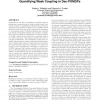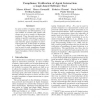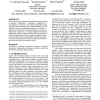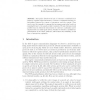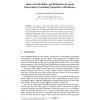SBP
2012
Springer
13 years 2 months ago
2012
Springer
Complex adaptive systems (CAS) modeling has become a common tool to study the behavioral dynamics of agents in a broad range of disciplines from ecology to economics. Many modelers...
ATAL
2011
Springer
13 years 6 months ago
2011
Springer
Researchers in the field of multiagent sequential decision making have commonly used the terms “weakly-coupled” and “loosely-coupled” to qualitatively classify problems i...
AAI
2006
14 years 7 months ago
2006
In open societies of agents, where agents are autonomous and heterogeneous, it is not realistic to assume that agents will always act so as to comply to interaction protocols. Thu...
ICMAS
1998
14 years 8 months ago
1998
Agentis is a framework for building interactive multiagent applications which is based upon a model of agent interaction whose key elements are services and tasks. Central to the ...
ATC
2006
Springer
14 years 8 months ago
2006
Springer
Abstract. Software agent technology has attracted much attention for developing various distributed systems, composed of autonomous agents interacting with one another using partic...
MABS
2000
Springer
14 years 10 months ago
2000
Springer
The effects of distinct agent interaction and activation structures are compared and contrasted in several multi-agent models of social phenomena. Random graphs and lattices repre...
ATAL
2003
Springer
15 years 4 days ago
2003
Springer
Discussions of agent interactions frequently characterize behavior as “coherent,” “collaborative,” “cooperative,” “competitive,” or “coordinated.” We propose a...
AOSE
2004
Springer
15 years 9 days ago
2004
Springer
Abstract. In this paper we introduce an approach for defining semantics for AUML agent interaction protocol diagrams using Petri net code structures. This approach is based on the...
ACOM
2004
Springer
15 years 9 days ago
2004
Springer
This paper describes the use of coherence constraints as a means to regulate agent interaction. Coherence constraints describe relationships between the content of utterances, and ...
SELMAS
2005
Springer
15 years 11 days ago
2005
Springer
Abstract. A crucial part of multi-agent system design is the design of agent interactions. Traditional approaches to designing agent interaction use interaction protocols, which fo...

